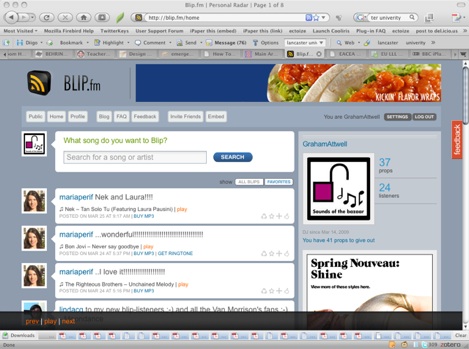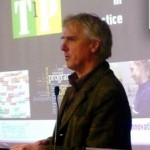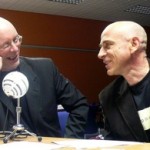I spent Monday in Riga developing a tender application to the European Commission on Enterprise 2.0. I am getting increasingly interested in the use of social software and Web 2.0 in enterprises and in particular the use of such applications for informal learning and knowledge development or – as it is coming to be called – knowledge maturing,. One important aspect of this is economic modelling and I think we have had too little cross over and collaboration between economists and researchers inTtechnology Enhanced Learning. Thus I was delighted to be working with Stockholm School of Economics in Riga and BICEPs from Riga in developing the application.
All too ofetn technology is een as a good thing in itself. In this blog I have often questioned the social aspects of introdcuing new technologies – sadly I have no expertise in the economic area. I think all these aspects are of particualr importance when it comes to policy and to detemining what sort of policy interventions are necessary with regard to stimulating and / or regulating the introduction of potentially disruptive technologies for the ways in which we live, learn, work and play.
Anyway hot on the heels of my musings in Latvia comes today the release of the snappily titled “Commission Staff Working Document. Accompanying document to the Communication from the Commission to the European Parliament, the Council, the European Economic and social Committee and the Committee of the Regions. Europe’s Digital Competitiveness Report. Volume 1: i2010 — Annual Information Society Report 2009 – Benchmarking i2010: Trends and main achievements.”
The report is accompanyed by the usual press release and executive summary full of policy hyperbole about the wonders of new technologies to overcome the recession. Europe, they say, “can advance even further as a generation of “digitally savvy” young Europeans becomes a strong market driver for growth and innovation. Building on the potential of the digital economy is essential for Europe’s sustainable recovery from the economic crisis.” But forget the political spin – there is a wealth of research and information in the 111 pages of the staff working paper.
I have had no time to read the full report – I am took busy working on my tender applciation – but here are a few key exerpts which caught my eye on a quick scroll through.
On use of the internet by young people
“Young people are active users of the internet as the main channel for information and communication purposes. “Digital natives”, i.e. people between 16 and 34, and especially those aged 16 to 24, most of them students, stand out as the most regular, intensive users of internet advanced services.
There is an evident, profound break with previous generations in the attitude towards the use of internet services. This is linked to the level of internet and informatics skills. The percentage of young people with medium internet skills is twice as much the European average (for all individuals aged 16-74) and the number of individuals aged 16 to 24 with IT skills obtained through formalised educational institution is three times higher than the average.
On average 43% of EU population accessed the Internet everyday or almost every day. However, this percentage increases more than 20 p.p. when it comes to people aged 16-24, with 66% of them accessing the internet everyday. In the most advanced countries, around 90% of young people connect on a daily basis. With the exception of Romania and Cyprus, in all countries the percentage of young people connecting to the internet everyday is higher than the average of the whole EU population. The difference between the whole EU population and the youngest users is about 23 p.p.. This difference lessens in the most advanced countries to about 18 p.p., but can be more than twice as much in the less advanced countries (Romania, Greece, Bulgaria, Portugal).
It is also worth noting that differences between countries are reduced when the 16-24 age group is taken as a reference. Besides the most developed countries, young people in Latvia, Portugal or Poland have similar frequency of use as in the UK, Germany or Belgium.”
On social particpation:
“The 2008 evidence above suggests that Internet use is associated with increased likelihood that users engage in civic activities (participation in social organizations23) within similar social backgrounds. While about half of internet users reported their participation in social activities, only a third of non-internet users did so. Similarly, frequent internet use is associated with higher levels of generalised trust.
The cross-sectional data used in the analysis do not allow concluding that the internet has a one way enhancing effect on social resources, as this can work the other way around too. Those with less social resources may be the ones who have fewer motivations or opportunities for using ICT and those who are rich in social resources might be more motivated for using the internet more frequently. In fact, most of the available analyses on the digital divide do suggest that the interrelation is one of reciprocal amplification.”
On business use of the internet:
“ICT benefits for businesses are normally expected to materialise through processes efficiency, innovation and market potential. Evidence shows that enterprises perceive ICT more as a tool for boosting productivity and reducing costs, rather than an instrument for increasing the number of reachable customers and the related turnover of the enterprises. This is consistent with findings on ICT take-up which show that applications aiming at increasing the enterprise internal efficiency are more widespread with respect to those enabling e-commerce. Similarly, only a minority of businesses consider ICT an enabler for the rollout of new products/services. Finally, large enterprises tend to be more positive when assessing the impact of ICT with respect to SMEs.”




